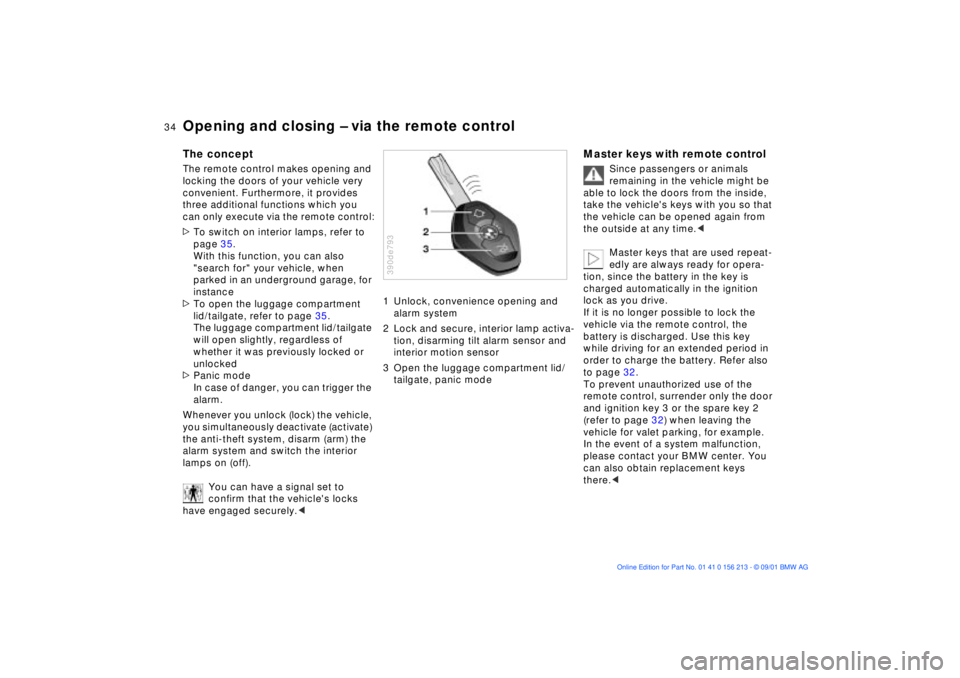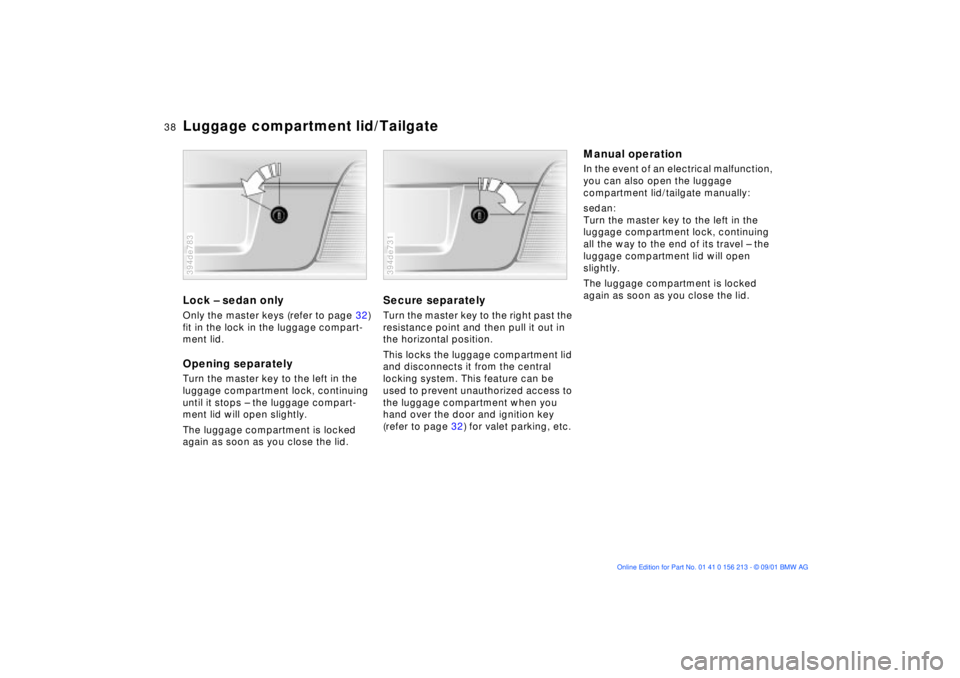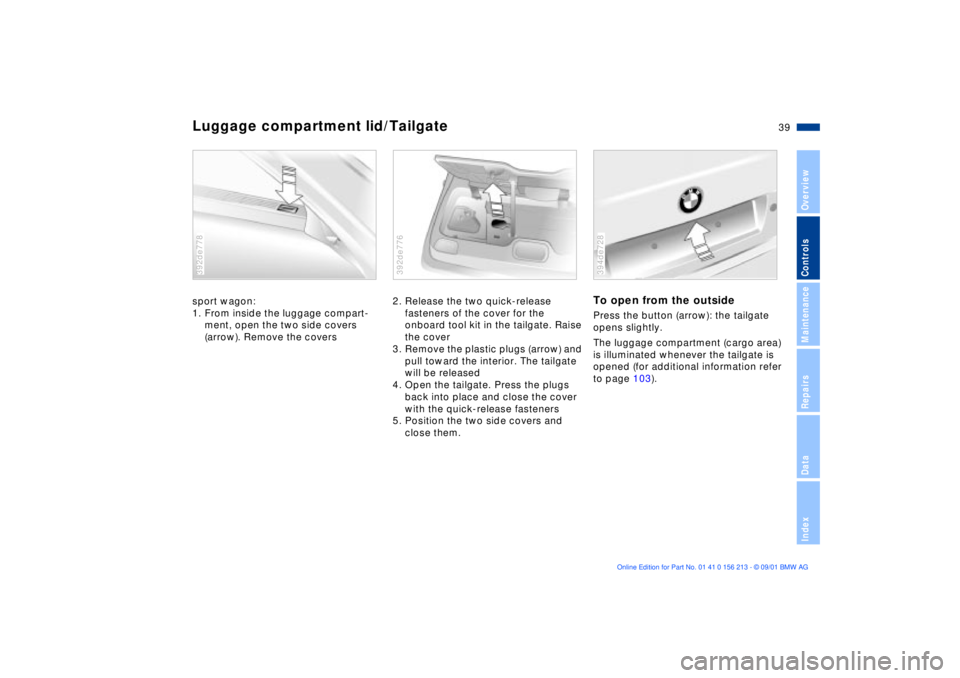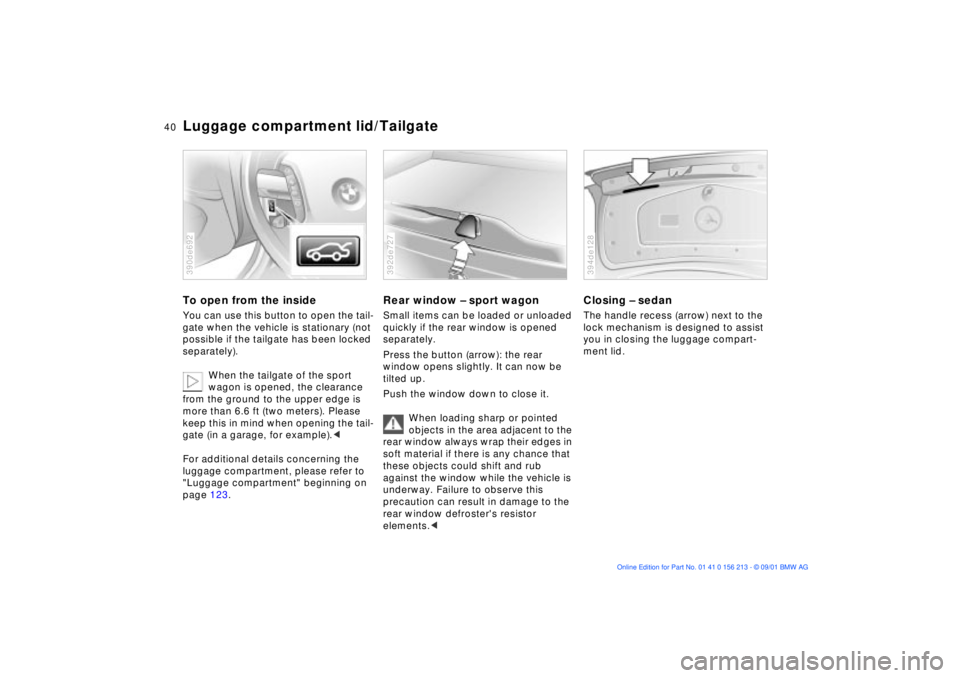2002 BMW 525I SPORT WAGON light
[x] Cancel search: lightPage 5 of 186

5n
OverviewControlsMaintenanceRepairsDataIndex
Controls and features
Operation, maintenance
Technology for safety and
driving convenience:
Park Distance Control (PDC)96
Automatic Stability Control plus
Traction (ASC+T)/Dynamic
Stability Control (DSC)97
Level control system99
Tire Pressure Monitor (RDC)99
Lamps:
Parking lamps/Low beams101
Instrument lighting102
High beams/Standing
lamps102
Fog lamps102
Interior lamps103
Reading lamps103
Controlling the climate for
pleasant driving:
Air conditioning104
Automatic climate control107
Roller sun blind112
Parked-car ventilation
system112
Cabin convenience:
BMW Universal Transmitter113
Glove compartment116
Storage compartments116
Cellular phone117
Beverage holder117
Ashtray, front117
Cigarette lighter118
Ashtray, rear118
Loading and transporting
cargo:
Through-loading system119
Ski bag120
sport wagon:
Luggage compartment123
Roll-up cover123
Partition net123
Storage areas in the luggage
compartment124
Cargo loading126
Roof-mounted luggage rack127
Special operating instructions:
Break-in procedures130
Driving notes131
Antilock Brake System131
Brake system132
Wheels and tires:
Tire inflation pressure133
Tire condition133
Tire replacement134
Wheel and tire
combinations135
Special characteristics of winter
tires136
Snow chains136
Page 19 of 186

19n
OverviewControlsMaintenanceRepairsDataIndex
Indicator and warning lamps
Technology that monitors itself
The system runs a check on the
warning and indicator lamps marked by
"
l
" each time you switch on the igni-
tion. They each light up once for
different periods of time.
If a fault should occur in one of these
systems, the corresponding lamp does
not go out after the engine is started or
it lights up while the vehicle is moving.
The following section describes how
you should respond.
Red: stop immediately
Battery charge current
l
The battery is no longer being
charged. This indicates a defect
in the alternator drive belt or in the
charging circuit of the alternator. Please
contact the nearest BMW center.
Stop and switch off the engine
immediately to prevent over-
heating and serious engine damage. If
the drive belt is defective, increased
steering effort is also required.
<
Engine oil pressure
l
May be accompanied by the
message "STOP!ENGINE
OILPRESS" in the Check Control
display panel
*
: stop the vehicle imme-
diately and switch off the engine. Check
the engine oil level; top up as required.
If the oil level is correct: please contact
the nearest BMW center.
Do not continue driving, as the
engine could sustain serious
damage from inadequate lubrication.
<
Tire Pressure Monitor (RDC)
*
l
Accompanied by an acoustic
warning signal: a tire failure has
occurred. Reduce vehicle speed imme-
diately and stop the vehicle. Avoid hard
brake applications. Do not oversteer.
For additional information: refer to
page 98
Parking brake
*
/
brake system hydraulic circuits
l
Comes on when you engage the
parking brake.
For additional information: refer to
page 68
Comes on although the parking brake
is released: have the brake fluid level
checked. Before continuing your
journey, be sure to read the notes on
pages 132 and 143
Also comes on with the message
"CHECK BRAKE LININGS" in the
Check Control.
Parking brake warning lamp
*
/
brake system hydraulic circuits
for Canadian models.
Page 21 of 186

21n
OverviewControlsMaintenanceRepairsDataIndex
Indicator and warning lamps
Self-leveling suspension
*
l
The level control system is inac-
tive. Please consult the nearest
BMW center.
For additional information: refer to
page 99
Automatic Stability Control plus
Traction (ASC+T)/Dynamic
Stability Control (DSC)
*
l
ASC+T/DSC has been deactivated,
either manually at the button or auto-
matically in response to a system
malfunction. In the event of a malfunc-
tion, have the system checked by your
BMW center.
For additional information: refer to
page 97
Engine-management system
*
There is a fault in the electronic
engine-management system.
You can continue to drive with reduced
engine output and engine speed.
Please have the system inspected by
your BMW center.
Service Engine Soon
l
If the indicator lamp comes on
either continuously or intermit-
tently, this indicates a fault in the emis-
sions-related electronic systems.
Although the vehicle remains opera-
tional, you should have the systems
checked by your BMW center at the
earliest possible opportunity.
For additional information: refer to
page 146
Service Engine Soon warning
lamp for Canadian models.
Check Filler Cap
*
l
If the indicator lamp comes on
although the fuel cap is secured
correctly: this indicates a malfunction in
the fuel system. Have the system
inspected at your BMW center at the
earliest opportunity.
Additional information: refer to page 25
Green: for your information
Turn signal
Flashes when the turn signal is
on. Rapid flashing indicates a
system malfunction.
For additional information: refer to
page 76
Cruise control
Lights up when the system is
switched on: available for oper-
ation via the multifunction steering
wheel.
For additional information: refer to
page 78
Front fog lamps
Lights up whenever you switch
on the front fog lamps.
For additional information: refer to
page 102
Blue: for your information
High beams
Lights up when the high beams
are on or the headlamp flasher
is actuated.
For additional information: refer to
pages 76 and 102
Page 34 of 186

34n
Opening and closing Ð via the remote controlThe conceptThe remote control makes opening and
locking the doors of your vehicle very
convenient. Furthermore, it provides
three additional functions which you
can only execute via the remote control:
>To switch on interior lamps, refer to
page 35.
With this function, you can also
"search for" your vehicle, when
parked in an underground garage, for
instance
>To open the luggage compartment
lid/tailgate, refer to page 35.
The luggage compartment lid/tailgate
will open slightly, regardless of
whether it was previously locked or
unlocked
>Panic mode
In case of danger, you can trigger the
alarm.
Whenever you unlock (lock) the vehicle,
you simultaneously deactivate (activate)
the anti-theft system, disarm (arm) the
alarm system and switch the interior
lamps on (off).
You can have a signal set to
confirm that the vehicle's locks
have engaged securely.<
1 Unlock, convenience opening and
alarm system
2 Lock and secure, interior lamp activa-
tion, disarming tilt alarm sensor and
interior motion sensor
3 Open the luggage compartment lid/
tailgate, panic mode390de793
Master keys with remote control
Since passengers or animals
remaining in the vehicle might be
able to lock the doors from the inside,
take the vehicle's keys with you so that
the vehicle can be opened again from
the outside at any time.<
Master keys that are used repeat-
edly are always ready for opera-
tion, since the battery in the key is
charged automatically in the ignition
lock as you drive.
If it is no longer possible to lock the
vehicle via the remote control, the
battery is discharged. Use this key
while driving for an extended period in
order to charge the battery. Refer also
to page 32.
To prevent unauthorized use of the
remote control, surrender only the door
and ignition key 3 or the spare key 2
(refer to page 32) when leaving the
vehicle for valet parking, for example.
In the event of a system malfunction,
please contact your BMW center. You
can also obtain replacement keys
there.<
Page 35 of 186

35n
OverviewControlsMaintenanceRepairsDataIndex
Opening and closing Ð via the remote controlTo unlockPress button.
Press the button once to unlock the
driver's door only; press a second time
to unlock all remaining doors as well as
the luggage compartment lid/tailgate
and fuel filler door.Convenience opening modePress and hold button to open the elec-
tric power windows and sliding/tilt
sunroof.
To lock and securePress button.
Vehicles without armored glass:
do not lock the vehicle if anyone
will be remaining inside, as it would
then be impossible for the occupant(s)
to disengage the locks from the
inside.< To deactivate the tilt alarm sensor
and interior motion sensorPress button a second time immedi-
ately after locking.
For additional information, refer to
page 43.To switch on the interior lampsWith the vehicle locked, press button.
To open the luggage
compartment lid/tailgatePress button.
The luggage compartment lid/tailgate
will open slightly, regardless of whether
it was previously locked or unlocked.
Before and after a trip, be sure
that the luggage compartment lid/
tailgate has not been opened uninten-
tionally.< Panic modeProvided that the alarm system is
armed, you can respond to imminent
danger by holding down the button for
between two and five seconds.
To cancel alarm
Press button.
Page 38 of 186

38n
Luggage compartment lid/TailgateLock Ð sedan onlyOnly the master keys (refer to page 32)
fit in the lock in the luggage compart-
ment lid.Opening separatelyTurn the master key to the left in the
luggage compartment lock, continuing
until it stops Ð the luggage compart-
ment lid will open slightly.
The luggage compartment is locked
again as soon as you close the lid.394de783
Secure separatelyTurn the master key to the right past the
resistance point and then pull it out in
the horizontal position.
This locks the luggage compartment lid
and disconnects it from the central
locking system. This feature can be
used to prevent unauthorized access to
the luggage compartment when you
hand over the door and ignition key
(refer to page 32) for valet parking, etc.394de731
Manual operationIn the event of an electrical malfunction,
you can also open the luggage
compartment lid/tailgate manually:
sedan:
Turn the master key to the left in the
luggage compartment lock, continuing
all the way to the end of its travel Ð the
luggage compartment lid will open
slightly.
The luggage compartment is locked
again as soon as you close the lid.
Page 39 of 186

39n
OverviewControlsMaintenanceRepairsDataIndex
Luggage compartment lid/Tailgatesport wagon:
1. From inside the luggage compart-
ment, open the two side covers
(arrow). Remove the covers392de778
2. Release the two quick-release
fasteners of the cover for the
onboard tool kit in the tailgate. Raise
the cover
3. Remove the plastic plugs (arrow) and
pull toward the interior. The tailgate
will be released
4. Open the tailgate. Press the plugs
back into place and close the cover
with the quick-release fasteners
5. Position the two side covers and
close them.392de776
To open from the outsidePress the button (arrow): the tailgate
opens slightly.
The luggage compartment (cargo area)
is illuminated whenever the tailgate is
opened (for additional information refer
to page 103).394de728
Page 40 of 186

40n
Luggage compartment lid/TailgateTo open from the insideYou can use this button to open the tail-
gate when the vehicle is stationary (not
possible if the tailgate has been locked
separately).
When the tailgate of the sport
wagon is opened, the clearance
from the ground to the upper edge is
more than 6.6 ft (two meters). Please
keep this in mind when opening the tail-
gate (in a garage, for example).<
For additional details concerning the
luggage compartment, please refer to
"Luggage compartment" beginning on
page 123.390de692
Rear window Ð sport wagonSmall items can be loaded or unloaded
quickly if the rear window is opened
separately.
Press the button (arrow): the rear
window opens slightly. It can now be
tilted up.
Push the window down to close it.
When loading sharp or pointed
objects in the area adjacent to the
rear window always wrap their edges in
soft material if there is any chance that
these objects could shift and rub
against the window while the vehicle is
underway. Failure to observe this
precaution can result in damage to the
rear window defroster's resistor
elements.< 392de727
Closing Ð sedanThe handle recess (arrow) next to the
lock mechanism is designed to assist
you in closing the luggage compart-
ment lid.394de128